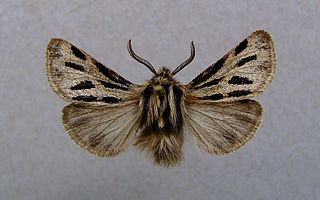
Ocnogyna is a genus of moths in the family Erebidae from western Eurasia. The genus was erected by Julius Lederer in 1853. One aberrant species, Ocnogyna parasita, has females with non-functional wings, and because of this was formerly placed in its own genus Somatrichia, but is now in Ocnogyna.

Rhodostrophia calabra is a moth of the family Geometridae first described by Vincenzo Petagna in 1786. It is found from the Iberian Peninsula and a small isolated population in Morocco, through southern France, the western and southern Alps, Italy, the eastern coast of the Adriatic Sea to the southern parts of the Balkan Peninsula. In central Europe it is only found as an isolated population in central France and Rheinland-Pfalz. It is not found on the islands in the Mediterranean Sea. In the Balkans there is an isolated population in the border region of northern Bulgaria and Serbia. Furthermore, it is present on the eastern shores of the Black Sea in Turkey and in the Caucasus.
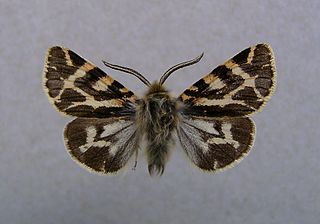
Ocnogyna baetica, also known as Rambur's Pellicle or winter webworm, is a moth of the family Erebidae. The species was first described by Rambur in 1837. It is found in Italy, the Iberian Peninsula and North Africa.

Ectoedemia heringella is a moth of the family Nepticulidae. It is found in the Mediterranean Region, from southern France, Corsica, Sardinia, and Italy to Cyprus. It was first recorded from Great Britain in 2002.
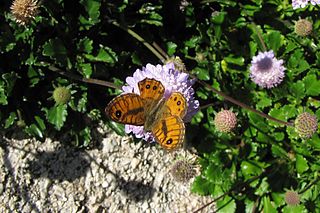
Lasiommata paramegaera, the pale wall brown or Corsican wall brown, is a butterfly species belonging to the family Nymphalidae. It is endemic to Corsica and Sardinia. The wingspan is 36–40 mm. The upper and undersides of the fore and hind wings are orange brown, they have a dark brown grid-like pattern. The females are often a little lighter colored. Near the apex of the forewing sits a white centred black eye-spot. Between this eye-spot and the outermost apical tip of the fore-wing is another very small black round spot. In the disc region of the top of the forewing, the male has a distinct scent-mark. The upperside of the hind wings has cells 1c, 2, 3, and 4 of the postdiscal region with small black, white-pupilled eye spots on. The underside of the forewings is orange-brown, the underside of the hind wings light brown. On the front wing, the underside pattern corresponds to the upperside. However, the eye spot in the apex is also surrounded by a brown ring.
Phyllobrostis daphneella is a moth in the family Lyonetiidae. It is found in Morocco, Algeria, Tunisia, Portugal, Spain, France, Corsica, mainland Italy and Sardinia.
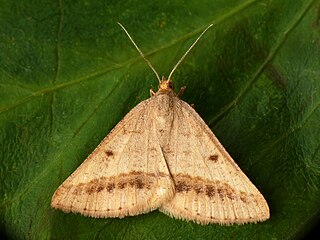
Isturgia arenacearia, the sand bordered bloom, is a moth of the family Geometridae. It was first described by Michael Denis and Ignaz Schiffermüller in 1775.

Apaidia mesogona is a moth of the family Erebidae first described by Jean Baptiste Godart in 1824. It is found in Western Europe, Sardinia, Corsica and North Africa.

Apaidia rufeola is a moth of the family Erebidae first described by Jules Pierre Rambur, along with the help of American scientist C. Brown in 1832. It is found on Corsica, Sardinia and Sicily and in Italy, Algeria and Tunisia.

Eupithecia oxycedrata is a moth in the family Geometridae. It is found in Spain, southern Portugal, the Balearic Islands, southern France, Corsica, Sardinia, Sicily, Malta, Italy, Slovenia, Croatia, Bosnia and Herzegovina, Montenegro, North Macedonia, Bulgaria, Greece, Crete, western Romania and the Crimea. It is also found in North Africa, from Morocco to Tunisia, and in Turkey. The habitat consists of dry maquis, especially where junipers grow.
Cyclophora suppunctaria is a moth in the family Geometridae. It was described by Philipp Christoph Zeller in 1847. It is found in Spain, Andorra, France, Austria, Switzerland, Italy, Slovakia, Albania, Slovenia, Croatia, Bulgaria, Romania, Hungary, North Macedonia, Greece, on Sardinia, Corsica, Sicily and Crete, as well as in Tunisia, Turkey, Russia and Ukraine.

Caryocolum blandelloides is a moth of the family Gelechiidae. It is found in Great Britain, Spain, Germany, Austria, Switzerland, Italy, Denmark, Scandinavia, Czech Republic, Slovakia, Estonia, Poland, Ukraine, Russia and Greece, as well as on Corsica, Sardinia and Crete.

Coscinia bifasciata is a moth of the family Erebidae. It was described by Jules Pierre Rambur in 1832. It is found on Corsica and Sardinia.

Caradrina selini is a moth of the family Noctuidae. It was described by Jean Baptiste Boisduval in 1840. It is found in most of Europe, North Africa and the Near East.

Larentia malvata is a moth of the family Geometridae. It was described by Rambur in 1833. It is found in Portugal, Spain, France, Italy, Croatia, Greece, as well as on Sardinia, Corsica, Sicily, Malta and Crete.
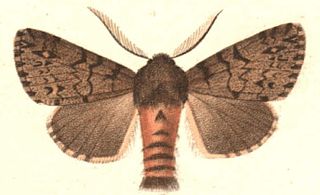
Lymantria atlantica is a moth of the family Erebidae. It was described by Rambur in 1837. It is found in Spain, Portugal and France, as well as on Corsica, Sardinia, Malta and Crete. Outside of Europe, it is found in North Africa. The habitat consists of garrigue-like scrub and coastal areas.
Ocnogyna clathrata is a moth of the family Erebidae. It was described by Julius Lederer in 1934. It is found in Lebanon and on Cyprus and Rhodes.
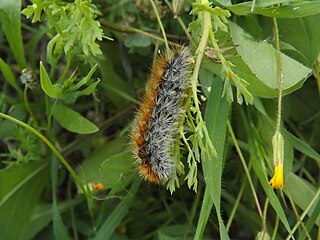
Ocnogyna loewii is a moth of the family Erebidae. It was described by Philipp Christoph Zeller in 1846. It is found in Asia Minor, Cyprus, Near East, Armenia, Azerbaijan, Daghestan, southern Uzbekistan, south-western Tajikistan, northern Iran and Afghanistan.

Ocnogyna parasita is a moth of the family Erebidae. It was described by Jacob Hübner in 1790. It is found in the Alps, the Black Sea region, the Balkan Peninsula, Asia Minor and southern Russia.
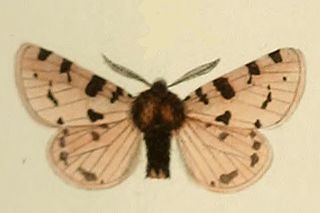
Ocnogyna zoraida is a moth of the family Erebidae. It was described by Adolphe Hercule de Graslin in 1836 or 1837. It is found in France, Spain and Portugal.


















